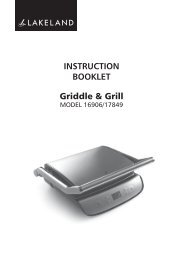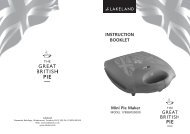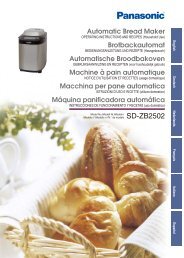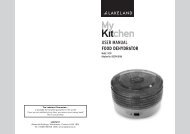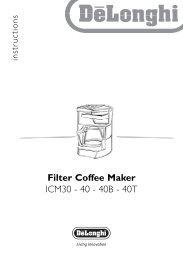12 Hole Cake Pop Maker Instructions - Lakeland
12 Hole Cake Pop Maker Instructions - Lakeland
12 Hole Cake Pop Maker Instructions - Lakeland
You also want an ePaper? Increase the reach of your titles
YUMPU automatically turns print PDFs into web optimized ePapers that Google loves.
CARE AND CLEANING• Before the first use and after every use, clean each part thoroughly.• Switch off at the wall and unplug the <strong>Cake</strong> <strong>Pop</strong> <strong>Maker</strong> and allow to cool completely beforecleaning. There are no parts to disassemble for cleaning.• The cooking plates should be conditioned with oil before each use by lightly coating eachmould with vegetable oil, using a heat resistant silicone or plastic soft pastry brush.• Periodically check all parts before reassembly.• Never immerse the appliance in water or other liquidsELECTRICAL CONNECTIONSTHIS APPLIANCE MUST BE EARTHEDThis appliance is fitted with a fused three-pin plug to BS1363 which is suitable for use in all homesfitted with sockets to current specifications. If the fitted plug is not suitable for your socket outlets,it should be cut off and carefully disposed of. To avoid an electric shock, do not insert the discardedplug into a socket.Fitting a new plugIf for any reason you need to fit a new plug, the flexible mains lead must be connected as shownhere. The wires in the mains lead fitted to this appliance are coloured in accordance with thefollowing code:• Never place the <strong>Cake</strong> <strong>Pop</strong> <strong>Maker</strong> in the dishwasher• Always use plastic, nylon or silicone spatulas etc. – metal tools will damage non-stick coatings.• Never immerse the unit in water or any other liquid.• To clean the unit and control panel, wipe with a clean, damp cloth and dry before storing.• Do not use abrasive cleaners, steel wool or abrasive materials or cleansers.• Always clean the outside of the cake <strong>Pop</strong> <strong>Maker</strong> and the top and bottom cooking plates aftereach use to prevent a build-up of baked-on foods.Neutral(blue)Earth(green/yellow)EL13amp FUSENLive(brown)13amp fuse• Store the <strong>Cake</strong> <strong>Pop</strong> <strong>Maker</strong> with the power cable loosely coiled around base. Never wrap ittightly around the appliance.• Ensure that the <strong>Cake</strong> <strong>Pop</strong> <strong>Maker</strong> is cooled, clean and dry before storing do not place anythingon top of the <strong>Cake</strong> <strong>Pop</strong> <strong>Maker</strong> when storing.RECYCLING YOUR ELECTRICALSAlong with many other high street retailers, <strong>Lakeland</strong> has joined a scheme whereby customers cantake their unwanted electricals to recycling points set up around the country.Visit www.recycle-more.co.uk to find your nearest recycling point.Connect BLUE to Neutral (N)Connect GREEN & YELLOW to Earth (E)Connect BROWN to Live (L)13 amp fuse to be usedIf the colours of the wires in the mains lead of this appliance do not correspond with the colouredmarkings identifying the terminals in your plug, proceed as follows. The wire which is colouredgreen and yellow MUST be connected to the terminal which is marked with the letter E (Earth)or coloured green. The wire which is coloured blue MUST be connected to the terminal which ismarked with the letter N (Neutral) or coloured black. The wire which is coloured brown MUST beconnected to the terminal which is marked with the letter L (Live) or coloured red.Before refitting the plug cover, check that there are no cut or stray strands of wire inside the plug.Use a 13 amp BS1362 fuse. Only BSI or ASTA approved fuses should be used. If you are at all unsurewhich plug or fuse to use, always refer to a qualified electrician.Note: after replacing or changing a fuse on a moulded plug which has a fuse cover, the cover mustbe refitted to the plug; the appliance must not be used without a fuse cover. If lost, replacementfuse covers can be obtained from an electrical shop. This appliance complies with the followingEEC Directives: 2006/95/EC (Low Voltage Directive) and 89/336 EEC (EMC Directive)18 19



